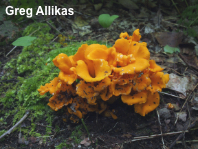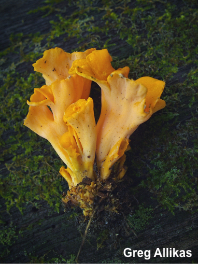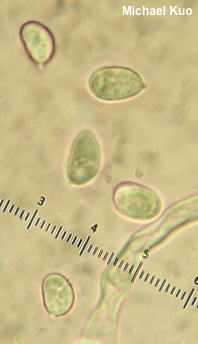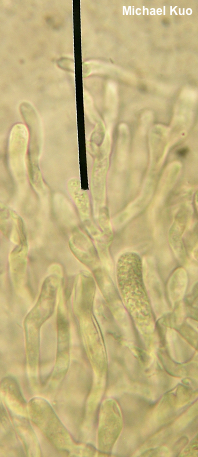| Major Groups > Chanterelles and Trumpets > Craterellus odoratus |

|
Craterellus odoratus [ Basidiomycota > Cantharellales > Cantharellaceae > Craterellus . . . ] by Michael Kuo Craterellus odoratus is a curious species found primarily in the southern Appalachian Mountains (although its range extends to Florida and Mexico) in association with oaks. It is deeply vase-shaped and thin-fleshed, like most species of Craterellus, but its colors are yellowish orange rather than gray or black. Cantharellus lateritius is superficially similar, but is meaty and thick-fleshed—and when it is "vase-shaped" it is only shallowly so. Confusion between Cantharellus lateritius and Craterellus odoratus has led to a number of taxonomic mistakes (see Petersen 1979 for a full accounting), but the two species are actually quite distinct and easily separated. Thanks to Greg Allikas for documenting, collecting, and preserving Craterellus odoratus for study; his collection is deposited in The Herbarium of Michael Kuo. Description: Ecology: Apparently mycorrhizal; associated with oaks, and perhaps with other hardwoods; growing in clusters; summer and fall; usually collected in the southern Appalachian Mountains (especially southern Ohio and North Carolina) but ranging to Florida and Texas, and into Mexico. The illustrated and described collection is from North Carolina. Fruiting Body: A cluster of individual fruiting bodies packed tightly together or joined at the stem bases. Individual caps 3–8 cm high; 1–3 cm wide; vase-shaped, without a clearly defined cap and stem. Upper/Inner Surface: Medium yellowish orange; bald or very finely scurfy; the margin wavy. Under/Outer Surface: Pale yellowish orange; bald; smooth; darker toward the base; bruising darker where handled; basal mycelium darker yellow-orange. Flesh: Thin and brittle; white to yellowish orange. Odor and Taste: Not distinctive. Spore Print: Not recorded. Microscopic Features: Spores 8–10 x 4.5–6 µ; subellipsoid; smooth; hyaline in KOH. Basidia 40–50 µm long; 2- and 4-sterigmate. Hymenial cystidia not found. Elements of upper surface forming a trichoderm; cylindric; septate; hyaline to yellowish in KOH; 2–7 µm wide; terminal cells with rounded or subclavate apices. Clamp connections not found. REFERENCES: (Schweinitz, 1822) Fries, 1838. (Burt, 1914; Coker, 1919; Corner, 1966; Petersen, 1979; Smith, Smith & Weber, 1981; Lincoff, 1992; Dahlman et al., 2000; Woehrel & Light, 2017; Elliott & Stephenson, 2018.) Herb. Kuo 08311901. This site contains no information about the edibility or toxicity of mushrooms. |
© MushroomExpert.Com |
|
Cite this page as: Kuo, M. (2019, November). Craterellus odoratus. Retrieved from the MushroomExpert.Com Web site: http://www.mushroomexpert.com/craterellus_odoratus.html |



